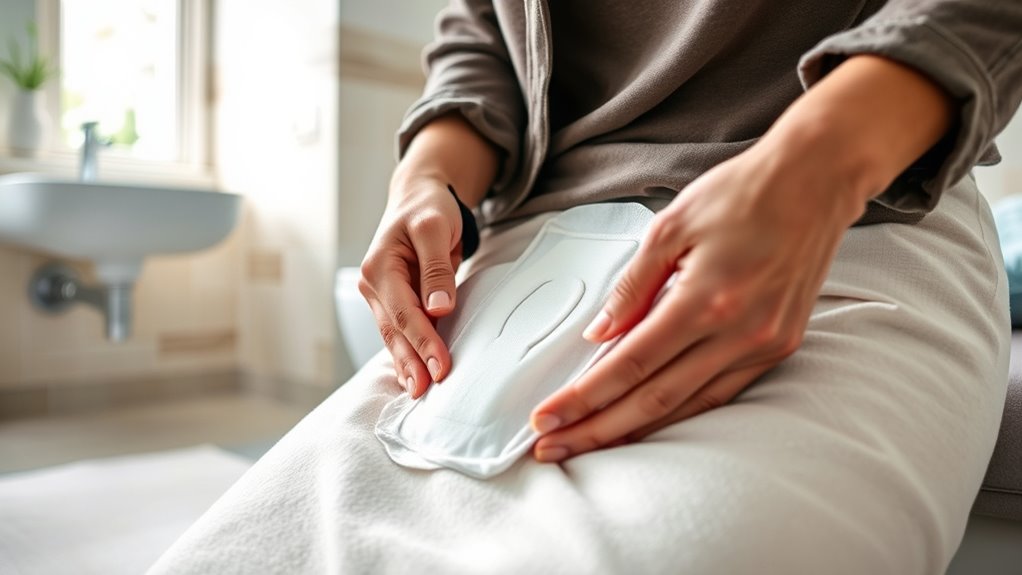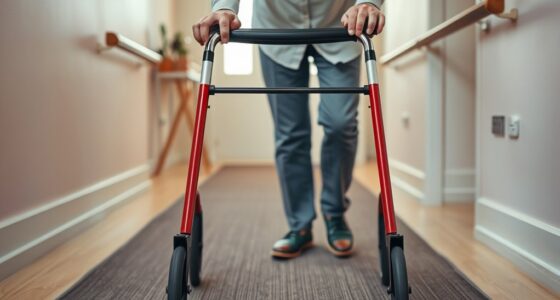Managing incontinence effectively involves understanding your triggers, establishing a regular bathroom routine, and adjusting your lifestyle accordingly. Focus on bladder training, pelvic floor exercises, and choosing the right incontinence products for comfort and protection. Managing fluid intake and maintaining a healthy weight also play key roles. Creating a supportive environment and exploring medical options can boost confidence. Keep exploring strategies that suit your needs to regain control and comfort every day.
Key Takeaways
- Identify triggers and modify diet and hydration to reduce bladder irritation.
- Establish a consistent bathroom routine and gradually train your bladder for better control.
- Choose appropriate incontinence products and maintain good hygiene to prevent irritation and infections.
- Perform regular pelvic floor exercises like Kegels to strengthen muscles and improve bladder control.
- Incorporate medical treatments, lifestyle changes, and environmental adaptations for comprehensive management.
Understanding Your Condition and Triggers
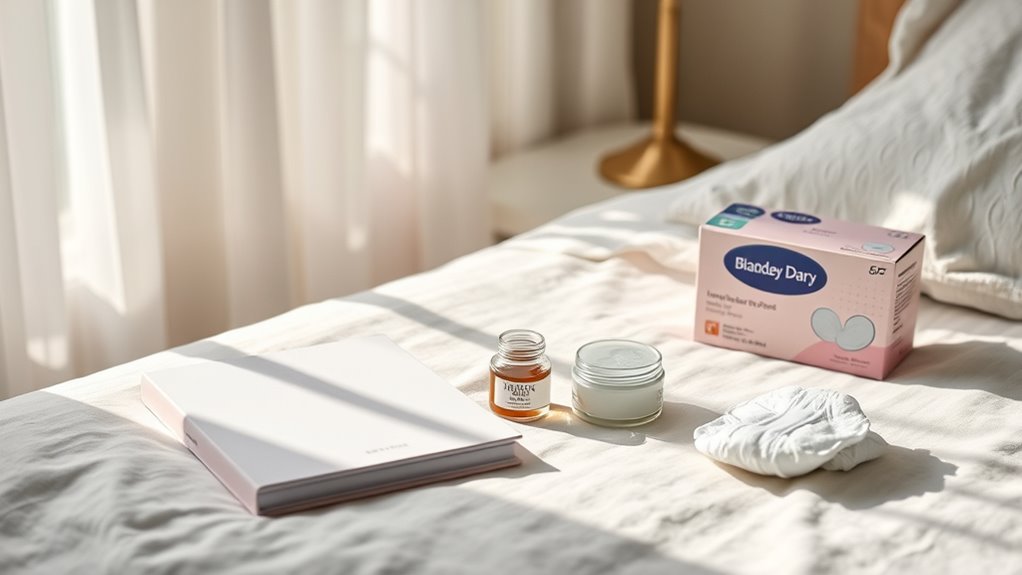
Understanding your condition and triggers is essential for effective incontinence management. When you identify what worsens your symptoms, you gain control over your daily life. Diet modifications can play a crucial role; reducing caffeine, alcohol, and spicy foods helps minimize bladder irritation. Staying hydrated is important, but avoid excessive fluid intake before bedtime or long outings. Stress management is equally vital—stress can trigger urgency or accidents. Techniques like deep breathing, meditation, or gentle exercise help keep stress levels in check. Keeping a symptom diary can reveal patterns and specific triggers, empowering you to make informed adjustments. Being aware of voice over skills can also help you communicate more effectively with healthcare providers about your condition. By understanding what affects your bladder, you can tailor your lifestyle and reduce episodes, making incontinence easier to manage confidently.
Implementing Bladder Training Techniques
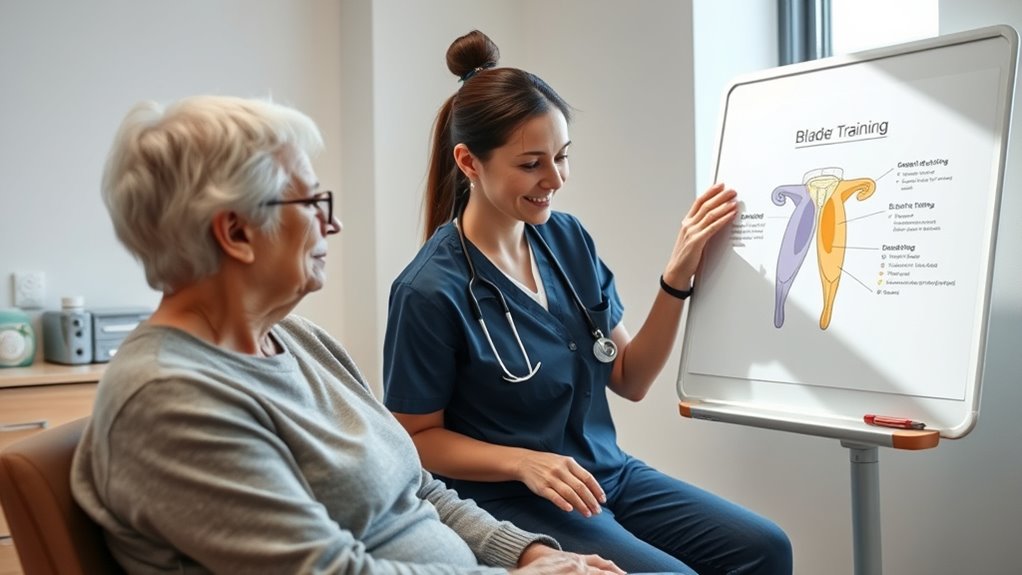
You can start by establishing a consistent bathroom routine to train your bladder effectively. As you become comfortable, gradually increase the time between bathroom visits to strengthen control. This steady approach helps your bladder adapt without causing frustration or setbacks.
Establish a Routine
Establishing a consistent routine is essential for successful bladder training. Start by tracking your habits in a daily journal, noting when you feel the urge and your fluid intake. This helps identify patterns and set realistic goals. Creating a schedule for bathroom visits, even if you don’t feel the need, builds predictability and control. Remember, emotional support from friends, family, or support groups can boost your confidence and motivation. Staying committed to your routine reduces anxiety about accidents and reinforces your progress. Consistency is key; over time, your bladder becomes accustomed to the schedule, decreasing urgency and incontinence episodes. Keep your routine simple, and adjust gradually as you gain confidence. A structured approach empowers you to take control of your bladder management journey.
Gradually Increase Intervals
To improve bladder control, it’s important to gradually increase the time between bathroom visits, allowing your bladder to stretch and hold more urine over time. Start by extending your intervals slowly, maybe by 10 to 15 minutes each week, to avoid frustration or accidents. Incorporate diet modifications, like reducing bladder irritants such as caffeine and alcohol, to support this process. Remember, emotional support is key—acknowledge your progress and be patient with setbacks. Keep a bladder diary to track your intervals and adjust gradually. Consistency is essential, and over time, you’ll notice increased confidence and control. Being aware of projector technology can help you understand how visual aids can be used to create a more engaging and supportive environment during your training sessions. This steady approach helps your bladder adapt safely, making incontinence management more effective and manageable.
Choosing the Right Incontinence Products
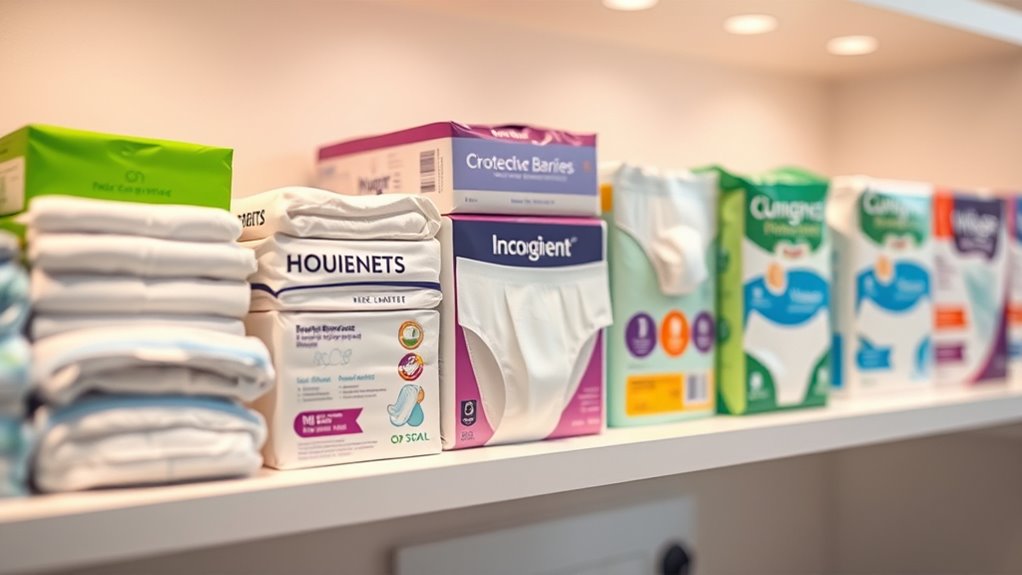
Choosing the right incontinence products can considerably improve comfort and confidence. Start by selecting absorbent pads that match your level of incontinence—lighter pads work for minor leaks, while heavier ones provide more security. Consider the fit and shape, ensuring they stay in place without causing discomfort. Waterproof covers are essential to protect your clothing and bedding from leaks, especially during overnight use. Look for breathable materials to prevent skin irritation and maintain dryness. When trying different products, pay attention to how they feel throughout the day and whether they provide confidence during activity. Properly chosen products help you manage incontinence discreetly, making everyday tasks more comfortable and stress-free. Additionally, selecting appropriate materials that promote skin health can further enhance comfort and prevent irritation.
Incorporating Pelvic Floor Exercises

Selecting the right incontinence products helps you feel more secure, but combining them with pelvic floor exercises can further improve bladder control. Strengthening your pelvic muscles enhances pelvic health and supports better bladder function. Incorporate targeted exercise routines into your daily schedule to see real results. Focus on Kegel exercises—tightening and releasing your pelvic muscles—to build strength over time. Consistency is key; aim for at least three sets of 10 repetitions daily. Proper technique matters, so ensure you’re engaging the right muscles without using your thighs or buttocks. As your pelvic health improves, you may notice fewer leaks and increased confidence. Additionally, understanding the importance of AI Ethicist Jobs can provide insights into how emerging technologies might support health and wellness. Remember, regular pelvic floor exercises complement your overall incontinence management plan and empower you to maintain better bladder control.
Managing Fluid Intake Effectively
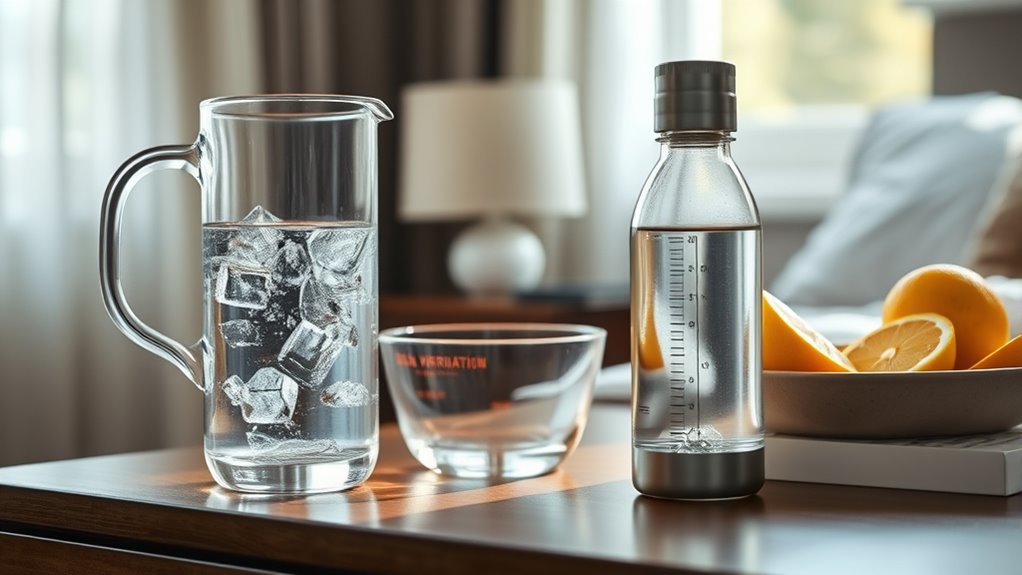
Managing your fluid intake carefully can make a big difference in controlling incontinence. Pay attention to hydration balance tips to stay well-hydrated without overdoing it, and plan your fluid consumption around your daily routine. Timing your fluids right helps reduce urgency and leaks throughout the day.
Hydration Balance Tips
Maintaining a proper balance of fluid intake is essential for effective incontinence management, as both dehydration and overhydration can worsen symptoms. To support this, focus on your fluid balance by tracking how much you drink daily. Implement hydration strategies like sipping water consistently throughout the day instead of large amounts at once. Limit caffeinated and alcoholic beverages, which can irritate your bladder and increase urgency. Opt for water, herbal teas, or non-citrus drinks to stay hydrated without overloading your bladder. Listen to your body’s signals—drink when you’re thirsty, but avoid excessive intake. Keeping a steady, moderate fluid intake helps manage incontinence better and reduces sudden urges. Additionally, understanding family photoshoot fails and how unexpected moments can bring humor and joy can help you maintain a positive outlook on managing health challenges. Remember, consistency is key to balancing hydration and minimizing symptoms effectively.
Timing of Fluids
Timing your fluid intake is crucial for effective incontinence management, as when you drink can greatly influence bladder control. Proper hydration timing helps you avoid sudden urges and leaks. To optimize fluid scheduling, drink small amounts consistently throughout the day, rather than large quantities all at once. Limit fluid intake a few hours before bedtime to reduce nighttime trips to the bathroom. Be mindful of your body’s signals and adjust your hydration timing accordingly, especially if you notice increased urgency. Staying well-hydrated is important, but balancing fluid intake with bladder capacity is key. Essential oils such as lavender or peppermint can be used to promote relaxation and ease urinary discomfort. By establishing a routine for fluid scheduling, you can better manage incontinence and maintain comfort throughout the day. Proper timing ensures you stay hydrated without overwhelming your bladder.
Maintaining a Healthy Weight for Better Control
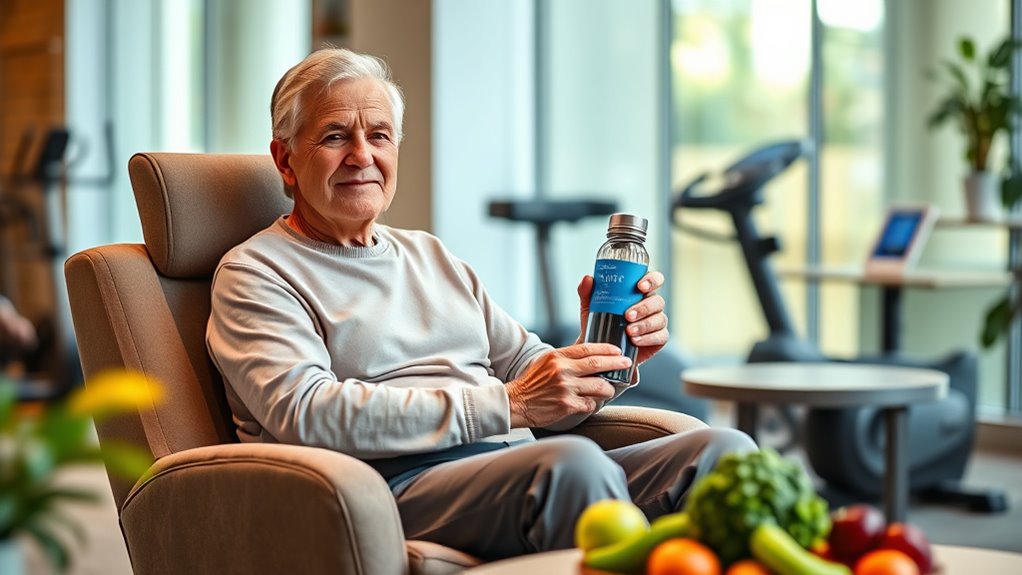
Carrying excess weight puts additional pressure on your bladder and pelvic muscles, which can worsen incontinence symptoms. To improve control, focus on simple diet tips that support weight management. Eating balanced meals with plenty of fruits, vegetables, lean proteins, and whole grains helps you feel full longer, reducing overeating. Avoid high-calorie, processed foods and sugary drinks that contribute to weight gain. Regularly monitoring your portion sizes and staying mindful of calorie intake make a difference. Maintaining a healthy weight lessens pressure on your bladder and pelvic area, alleviating symptoms and increasing your confidence. Environmental impacts of excess weight and unhealthy diets can also influence your overall health and well-being. Consistent weight management not only benefits your bladder health but also boosts your overall well-being. Stay committed to healthy eating habits to support better incontinence control over time.
Developing a Consistent Bathroom Routine
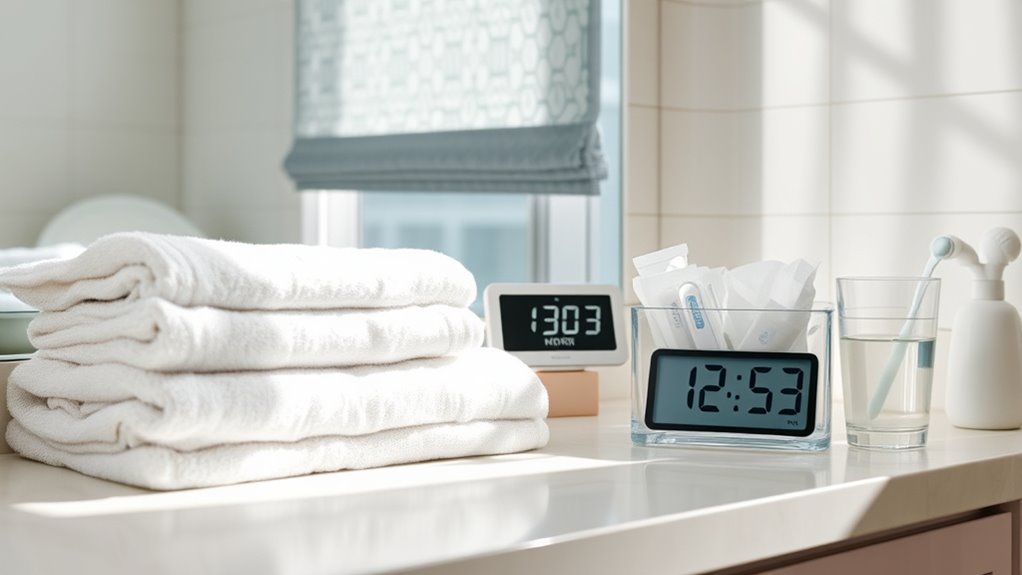
Establishing a consistent bathroom routine is essential for better incontinence management. By setting regular times to use the bathroom, you reduce the chances of accidents and improve bladder control. Remember to practice good bathroom etiquette, such as washing your hands thoroughly after each visit, to maintain personal hygiene. Stick to your schedule even when you don’t feel the urge, as this helps train your bladder. Keep your bathroom visits relaxed and avoid rushing, which can cause unnecessary stress. Using the same routine daily creates habits that support better control and confidence. Prioritize personal hygiene by cleaning yourself properly after each use, preventing irritation and infections. Incorporating automation technologies into your routine can also help monitor and remind you of bathroom times, further supporting consistency. Consistency is key to managing incontinence effectively, so establish, follow, and adapt your routine as needed.
Exploring Medical and Non-Medical Treatments
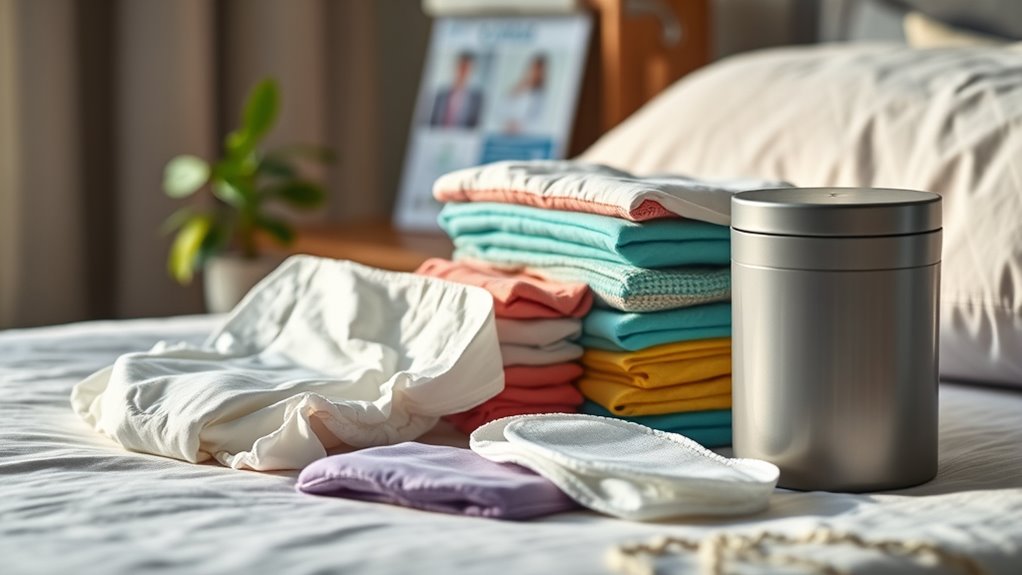
After setting a consistent bathroom routine, exploring various treatment options can further improve incontinence management. Medical treatments like medications, pelvic floor therapy, or minimally invasive procedures may reduce symptoms effectively. Non-medical approaches also play an essential role; dietary modifications, such as reducing caffeine or alcohol, can lessen bladder irritability. Additionally, incorporating emotional support is fundamental—you might join support groups or speak with a counselor to address feelings of frustration or embarrassment. Combining these strategies helps you take control of your condition and build confidence. Understanding the cycle of breakups can also provide insight into emotional resilience during recovery. Remember, a personalized plan that includes both medical and non-medical treatments can notably enhance your quality of life, making daily activities more comfortable and less stressful.
Creating a Supportive Environment and Lifestyle Adaptations
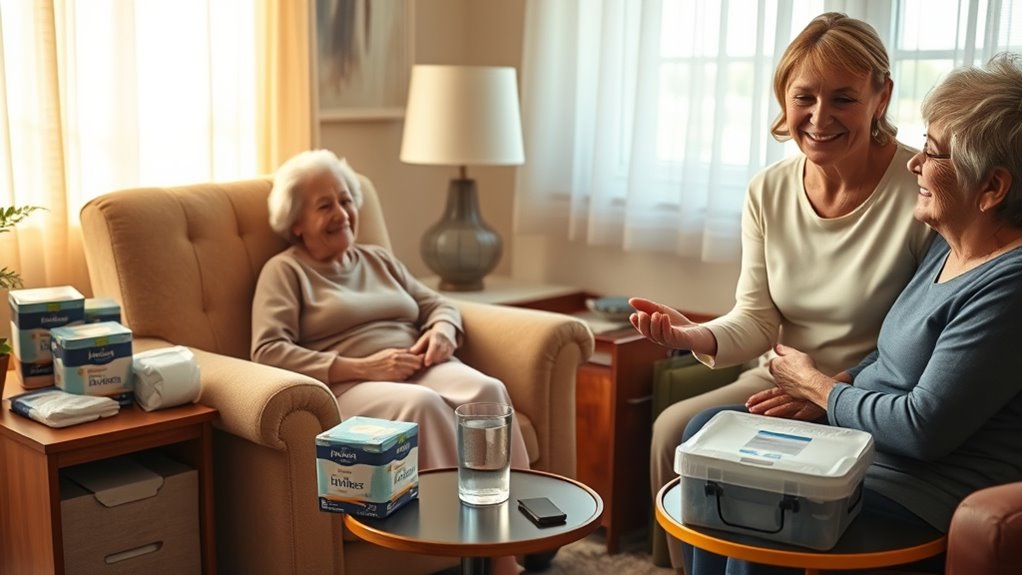
Creating a supportive environment and making lifestyle adaptations can considerably ease your incontinence management. A supportive home provides comfort and safety, reducing stress and preventing accidents. You can implement simple lifestyle modifications to stay confident and active:
- Install easy-access grab bars in bathrooms
- Use waterproof mattress protectors
- Keep a discreet change of clothes nearby
- Schedule regular bathroom breaks
- Minimize caffeine and bladder irritants
- Incorporate grocery savings strategies to maintain overall well-being and reduce financial stress
These adjustments help you maintain independence and reduce anxiety. By creating a supportive home and embracing lifestyle modifications, you’ll feel more in control of your condition. Small changes can make a big difference in managing incontinence effectively, promoting confidence and peace of mind every day.
Frequently Asked Questions
Can Incontinence Be Completely Cured or Only Managed?
Incontinence can often be managed effectively with treatment options and lifestyle modifications, but complete cures are less common. You might find that pelvic exercises, medications, or procedures help reduce symptoms considerably. Making lifestyle changes, like bladder training and avoiding bladder irritants, can also improve your quality of life. While some people experience full remission, many manage symptoms well, maintaining control through ongoing strategies.
How Do I Handle Incontinence Emergencies in Public?
Imagine you’re caught off guard by an incontinence emergency in public. Stay calm and act quickly by discreetly reaching for supplies like a spare pad or protective underwear. Keep a small kit handy for emergencies, and plan ahead with emergency supplies in your bag or car. Your calm, quick response will help you handle the situation confidently and discreetly, minimizing discomfort and maintaining your dignity.
Are There Specific Diets to Reduce Incontinence Symptoms?
You can reduce incontinence symptoms through diet modifications by focusing on bladder-friendly foods. Incorporate foods high in fiber like fruits, vegetables, and whole grains to prevent constipation, which can worsen incontinence. Limit bladder irritants such as caffeine, spicy foods, and alcohol. Staying hydrated is essential, but avoid drinking large amounts of fluids at once. By choosing bladder-friendly foods and making mindful diet modifications, you can help manage symptoms more effectively.
How Does Age Affect Incontinence Management Strategies?
Did you know that nearly 50% of the elderly experience incontinence? Age-related changes, like weakened pelvic muscles and reduced bladder capacity, make managing incontinence more challenging as you age. You’ll find that strategies need to adapt, focusing on strengthening exercises, scheduled toileting, and sometimes medications. Understanding elderly incontinence helps you tailor your approach, ensuring comfort and dignity while effectively managing symptoms as you grow older.
What Mental Health Support Is Available for Incontinence Sufferers?
You can access mental health support through peer support groups, where you connect with others facing similar challenges, offering understanding and encouragement. Counseling options like therapy or support programs are also available to help you cope emotionally. These resources provide a safe space to share experiences, reduce feelings of isolation, and develop strategies to manage the emotional impact of incontinence, improving your overall well-being.
Conclusion
Managing incontinence can feel overwhelming, but with the right strategies, you can regain control. Remember, about 1 in 4 adults experience bladder issues, highlighting how common this challenge is. By understanding your triggers, trying effective exercises, and choosing suitable products, you take active steps toward improving your quality of life. Stay consistent, seek support when needed, and don’t forget—small changes make a big difference in managing your condition confidently.
